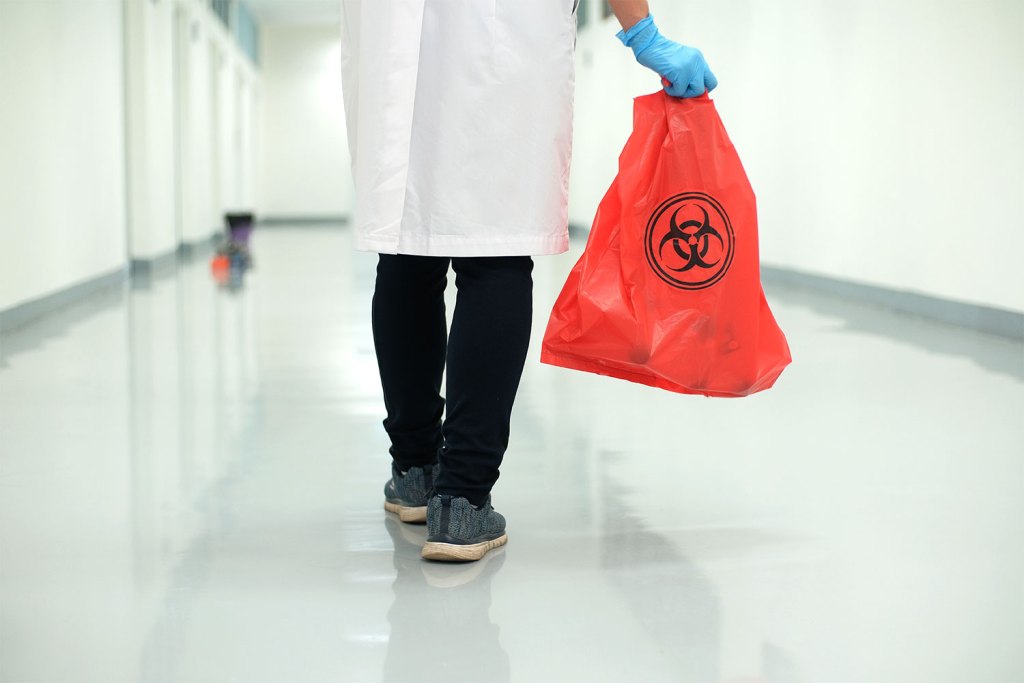If you have dealt with biohazardous materials, you know the importance of practicing strict safety methods when around them. Biohazardous waste is any waste containing infectious materials or potentially infectious substances. Blood would be an example of this. Biohazardous waste can also be referred to as infectious waste or biomedical waste. Regardless of what you call it, it can be gross, stinky, and highly dangerous. Getting rid of the mess can be a challenge. You can’t just throw it in your kitchen trash can without risking the spread of disease or other damages.
Whether you are in a laboratory every day or encounter such material rarely, it is important to know how to handle it. Biohazard waste bags significantly reduce the many risks associated with such waste. They make the disposal process safe and efficient, and are the only way to correctly get rid of biohazardous material.

Biohazard waste bags: What are they?
You have probably seen these bags before. These bright red plastic bags display an eye-catching biohazard symbol to make anyone wary of its contents. These bags are made from printed polypropylene and are 0.03mm (0.0012″) thick. They are required to be made from a material that meets or exceeds the Dart Impact Resistance Test. This test assesses the strength of the bag in case sharp or heavy items are placed within one. They must be impervious to moisture and be strong enough to resist ripping, tearing, or bursting. The biohazard waste bags can come be red or clear and must always clearly display the biohazard symbol and word.
Who should use them?
Anyone may need to use a biohazard waste bag. It just depends on your unique circumstances. These bags are mainly used to separate infectious waste that must be sterilized from regular garbage. If you fail to correctly dispose of biohazardous waste, you are putting many people at risk. You can harm yourself, your neighbors, your garbagemen, and the environment. Most of the time, these bags are used by people in labs or hospitals. They can also be used in every common household. Whoever needs to dispose of specific items that belong in a biohazard waste bag (see the next section) should use them.
What belongs in a biohazard waste bag?
This list states the many items you can and should put into a biohazard waste bag. OPIM stands for other potentially infectious materials and include: Semen, vaginal secretions, cerebrospinal fluid, synovial fluid, pleural fluid, pericardial fluid, peritoneal fluid, amniotic fluid, saliva, body fluid that is visibly contaminated with blood, all body fluids in situations where it is difficult or impossible to differentiate between body fluids, and any tissue or organ from a human.
- Liquid or semi-liquid blood or OPIM, including: Blood in blood tubes, blood or OPIM in suction canisters
- Contaminated items that would release blood or OPIM in a liquid or semi-liquid state if compressed, this includes: Blood-soaked gauze
- Items that are caked with dried blood or OPIM and are capable of releasing these materials during handling, this includes: Blood-soaked gauze that has dried and the blood could flake off
- Bloody gloves
- Contaminated sharps, including: Needles, syringes with needles attached, scalpels with blood on them
- Pathological and microbiological wastes containing blood or OPIM

What to avoid putting in a biohazard waste bag?
This list states the many items you want to avoid placing in a biohazard bag.
- Food and common trash items
- Packaging
- Table paper and covers
- Tissues and paper towels
- Diapers and pads
- Gowns and masks unless soaked with blood or OPIM
- Sanitary napkins
- IV bags
- Patient drapes
- Urine, feces, or vomitus or items soiled with these
- Urine cups with no visible blood
- Hazardous/bulk chemo waste
- Trace chemo waste
- Pharmaceutical waste
- Chemicals
- Radioactive waste
- Materials that contain lead
- Human remains
- Compressed gas cylinders, inhalers, or aerosol cans, even if the container is empty
- Glass thermometers and any medical device or solutions containing mercury
Getting rid of biohazard waste bags
Red medical waste bags must never be disposed of or collected by municipal or city waste collectors. Only licensed medical waste contractors are allowed to collect and dispose of filled red bags. Once safely filled and closed, call your local waste contractors to set up an arrangement for pickup. If you have access to one, you can also put the biohazard waste bag into a biohazard waste bin.
Regardless of your need for one, a biohazard waste bag is a vital part of disposing of infectious material. It is important to know what can go into a bag and how to safely get rid of one. Always remember to use protective safety equipment such as gloves and goggles when handling biohazardous material, and you’ll be on your way to a safe and clean environment.


